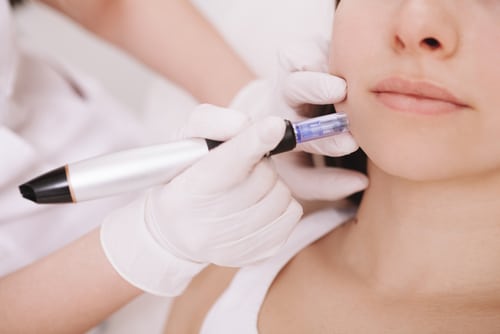Rosacea is a chronic skin condition characterized by facial redness, visible blood vessels, and acne-like bumps. It affects millions of people worldwide, causing not only physical discomfort but also significant emotional distress. While there is no known cure for rosacea, various treatment modalities aim to manage its symptoms effectively. One such treatment gaining attention is microneedling. In this blog post, we will explore the potential benefits of microneedling for rosacea, its mechanism of action, and the existing evidence supporting its use.
Understanding Rosacea
Before delving into microneedling’s potential effects on rosacea, let’s first gain a basic understanding of this skin condition. Rosacea is a chronic inflammatory disorder primarily affecting the face, typically appearing in adulthood. It is characterized by symptoms such as persistent facial redness, flushing, papules, pustules, and in some cases, eye involvement. The exact cause of rosacea remains unknown, making treatment challenging.
What is Microneedling?
Microneedling, also known as collagen induction therapy or percutaneous collagen induction, is a minimally invasive procedure that involves using fine needles to create controlled micro-injuries in the skin. These tiny punctures stimulate the body’s natural wound healing response, triggering the production of new collagen and elastin fibers. As a result, the skin becomes smoother, firmer, and more even in tone and texture.
The Potential Benefits of Microneedling for Rosacea
While microneedling is widely recognized for its efficacy in addressing various skin concerns such as acne scars, fine lines, and wrinkles, its potential role in managing rosacea is still being explored. Although research on microneedling specifically for rosacea is limited, several mechanisms suggest its potential benefits:
1. Enhanced Delivery of Topical Medications:
Microneedling creates microchannels in the skin, enabling better penetration of topical medications. This could be advantageous for delivering anti-inflammatory agents or rosacea-specific treatments directly to the affected areas, potentially improving their effectiveness.
2. Collagen Stimulation and Skin Remodeling:
Microneedling stimulates collagen production, which may help strengthen the skin’s barrier function and reduce the appearance of blood vessels. This could potentially alleviate some of the symptoms associated with rosacea, such as facial redness and flushing.
3. Reduction of Scar Tissue:
In cases where rosacea has led to scar formation, microneedling has shown promise in minimizing the appearance of scars. By promoting collagen remodeling, microneedling may help improve the texture and overall appearance of the skin affected by rosacea.
Existing Evidence and Clinical Studies
While further research is needed to establish microneedling as a definitive treatment option for rosacea, early studies have shown encouraging results. For instance, a study published in the Journal of Cosmetic Dermatology reported that microneedling combined with vitamin C significantly improved erythema (redness) and telangiectasia (dilated blood vessels) associated with rosacea. Another study published in the Journal of Dermatological Treatment found that microneedling improved overall skin texture and reduced inflammatory lesions in rosacea patients.
It is important to note that microneedling should be performed by a trained professional in a controlled clinical setting to ensure safety and maximize its potential benefits.
Conclusion
Microneedling holds promise as a potential treatment modality for rosacea, although further research is needed to establish its efficacy and define the optimal protocols. By stimulating collagen production, enhancing topical medication delivery, and potentially reducing scar tissue, microneedling may offer a multifaceted approach to manage the symptoms of rosacea.

